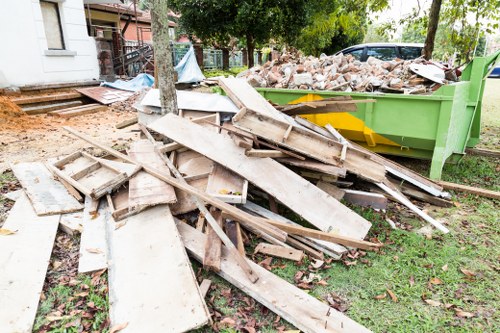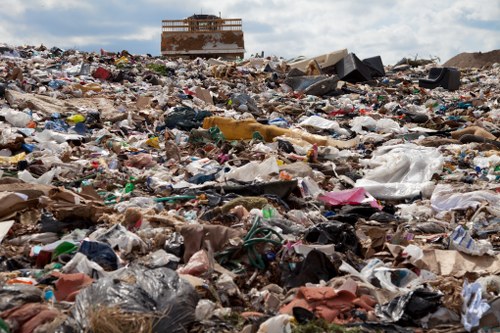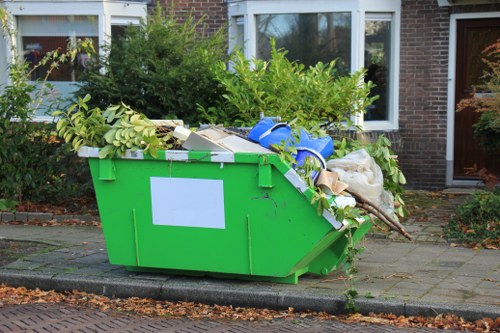Construction Waste Disposal in Neasden: Efficient and Sustainable Solutions
Understanding Construction Waste in Neasden

Construction activities in Neasden, a bustling area of London, generate a significant amount of waste. Effective construction waste disposal is essential not only for maintaining the aesthetic appeal of the neighborhood but also for environmental sustainability.
**Why Proper Waste Disposal Matters**
Improper disposal of construction waste can lead to various issues, including environmental degradation, health hazards, and legal consequences. By adopting efficient disposal methods, builders and contractors can mitigate these risks.
Neasden’s unique urban landscape necessitates tailored waste management strategies to handle the specific types of waste generated in construction projects.
Types of Construction Waste

Construction waste can be categorized into several types, each requiring different disposal methods. Common categories include:
- **Demolition Waste**: Materials from dismantling structures, such as bricks, concrete, and wood.
- **Excavation Waste**: Soil and other materials removed during earthworks.
- **Packaging Waste**: Materials used to package construction supplies, like cardboard and plastic.
- **Hazardous Waste**: Substances that pose potential risks, including asbestos and chemicals.
Proper classification of waste is the first step in effective disposal and recycling.
Implementing categorization systems helps in segregating waste at the source, facilitating easier recycling and reducing the overall environmental footprint.
Regulations and Compliance in Neasden

Neasden is subject to strict waste management regulations aimed at minimizing the environmental impact of construction activities. Compliance with these regulations is mandatory for all construction projects.
Key Regulations:
- Waste Management Licensing: Ensuring proper handling and disposal of construction waste.
- Recycling Requirements: Mandates on the percentage of waste that must be recycled.
- Hazardous Waste Handling: Specific protocols for the disposal of dangerous materials.
Staying informed about these regulations helps contractors avoid fines and contributes to sustainable development in Neasden.
Regular audits and inspections are conducted to ensure adherence to waste management standards.
Effective Waste Disposal Methods

Adopting effective waste disposal methods is crucial for reducing the environmental impact of construction projects in Neasden. Some of the most efficient methods include:
- Recycling and Reusing: Materials like metal, wood, and concrete can be recycled or repurposed for other projects.
- Waste Minimization: Implementing strategies to reduce the amount of waste generated during construction.
- On-site Segregation: Sorting waste at the source to streamline the disposal process.
These methods not only help in complying with regulations but also contribute to cost savings and environmental conservation.
Investing in recycling facilities and training staff on waste management best practices can further enhance disposal efficiency.
Choosing the Right Waste Disposal Service

Selecting a reliable construction waste disposal service in Neasden is essential for ensuring that waste is handled responsibly and efficiently. Factors to consider include:
- **Licensing and Certification**: Ensure the service provider complies with local waste management regulations.
- **Recycling Capabilities**: Opt for services that prioritize recycling and reuse of materials.
- **Timeliness and Reliability**: Choose providers that can adhere to project schedules.
- **Cost-Effectiveness**: Evaluate pricing structures to find services that offer value without compromising quality.
Partnering with the right disposal service can streamline the waste management process, allowing construction teams to focus on their core activities.
Researching and comparing different providers can help in making an informed decision that aligns with project goals and sustainability targets.
Benefits of Proper Waste Disposal

Implementing effective construction waste disposal practices in Neasden offers numerous benefits:
- Environmental Protection: Reduces pollution and conserves natural resources.
- Cost Savings: Lowers expenses associated with waste removal and material purchases.
- Enhanced Reputation: Demonstrates commitment to sustainability, attracting eco-conscious clients.
- Regulatory Compliance: Avoids legal penalties and ensures smooth project approvals.
These advantages highlight the importance of integrating waste disposal strategies into construction planning.
Long-term sustainability and operational efficiency are achievable through diligent waste management practices.
Innovative Technologies in Waste Disposal

The advancement of technology has introduced innovative solutions for construction waste disposal in Neasden. Some notable technologies include:
- Automated Sorting Systems: Enhance the accuracy and speed of waste segregation.
- Recycling Machinery: Advances in equipment for processing recyclable materials.
- Waste Tracking Software: Facilitates monitoring and management of waste streams.
Adopting these technologies can significantly improve the efficiency and effectiveness of waste disposal operations.
Continuous investment in technological innovations ensures that waste management practices remain up-to-date and effective.
Community Impact and Engagement
Effective construction waste disposal not only benefits the immediate project but also has a broader impact on the Neasden community. Engaging with the community involves:
- **Public Awareness Campaigns**: Educating residents about the importance of proper waste disposal.
- **Collaborative Initiatives**: Partnering with local organizations to promote sustainability.
- **Feedback Mechanisms**: Allowing community members to provide input on waste management practices.
Fostering a collaborative approach ensures that waste disposal efforts align with community values and needs.
Building strong community relationships enhances the overall success of waste management initiatives.
Cost Analysis of Waste Disposal Methods
Understanding the financial implications of different waste disposal methods is crucial for budgeting and cost management in construction projects.
**Factors Influencing Costs**:
- **Type of Waste**: Hazardous waste typically incurs higher disposal fees.
- **Volume of Waste**: Larger volumes may benefit from bulk disposal rates.
- **Transportation Expenses**: Distance and logistics affect overall costs.
- **Recycling Opportunities**: Revenue from recycled materials can offset disposal costs.
Conducting a comprehensive cost analysis helps in selecting the most economical and effective waste disposal strategies.
Implementing cost-saving measures such as waste minimization can significantly reduce overall project expenses.
Future Trends in Construction Waste Disposal
The field of construction waste disposal is continuously evolving, driven by technological advancements and increasing environmental awareness. Future trends include:
- Zero Waste Construction: Striving for minimal to no waste generation through innovative building practices.
- Circular Economy: Emphasizing reuse and recycling to maintain materials within the economy.
- Advanced Waste Treatment: Utilizing cutting-edge technologies for efficient waste processing.
Staying abreast of these trends ensures that waste disposal practices remain sustainable and relevant.
Forward-thinking strategies will play a pivotal role in shaping the future of construction waste management in Neasden.
Implementing Sustainable Practices
Adopting sustainable waste disposal practices is essential for the long-term viability of construction projects in Neasden. Key practices include:
- Source Reduction: Minimizing waste at the planning and design stages.
- Material Selection: Choosing eco-friendly and recyclable materials.
- Efficient Resource Management: Optimizing the use of resources to reduce excess.
These practices contribute to a more sustainable construction industry and promote environmental stewardship.
Integrating sustainability into every phase of construction enhances the overall success and reputation of projects.
Conclusion
Construction waste disposal in Neasden is a critical aspect of sustainable development. By understanding the types of waste, adhering to regulations, and adopting effective disposal methods, construction projects can significantly reduce their environmental impact.
Investing in proper waste management not only ensures compliance but also fosters a positive relationship with the community and enhances the overall efficiency of construction operations.
For those embarking on construction projects in Neasden, prioritizing waste disposal is a step towards a greener and more sustainable future.
Contact us today to learn more about our comprehensive waste disposal services tailored for Neasden's construction landscape.